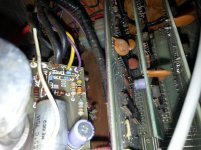falter
Veteran Member
I think this one will be directed at Chuck mostly.. Chuck do you know if there was an operation manual for the ct-1024? I've looked all over Matt Holleys site.. he has assembly instructions that give a bit of info on starting the unit up for testing.. but not much else. I'm trying to figure out how to run it in just tv typewriter modr.. to see if the keyboard works. Im getting replacement capacitors.. and i dont think the serial board is working.. but there is a switch that brings up a page of ? marks and I seem to recall reading *somewhere* that there was a keystroke or button or something that prepared the unit for typing. I just want to see the extent of functionality if I can.
One other question... off one of the leads from the power supply I'm getting 12.95v.. is that likely tied into the old capacitor issue? I'm hoping i've ordered the right replacements. All the originals were measured in mfd.. had tobuse a calculator to try and figure out the uf equivalents.
One other question... off one of the leads from the power supply I'm getting 12.95v.. is that likely tied into the old capacitor issue? I'm hoping i've ordered the right replacements. All the originals were measured in mfd.. had tobuse a calculator to try and figure out the uf equivalents.


